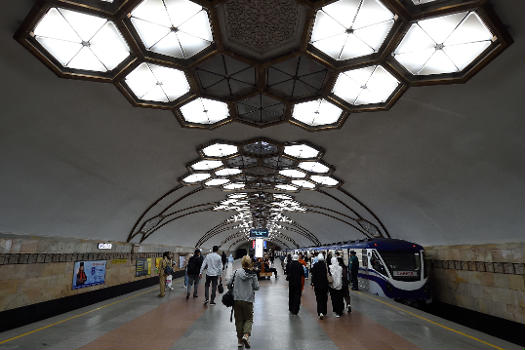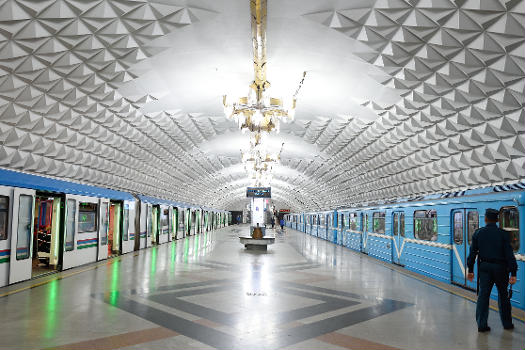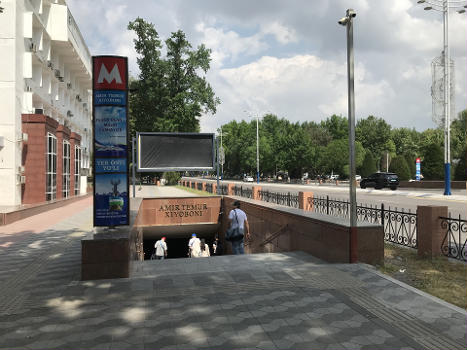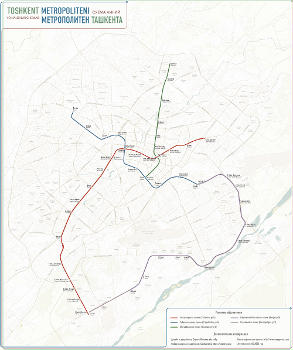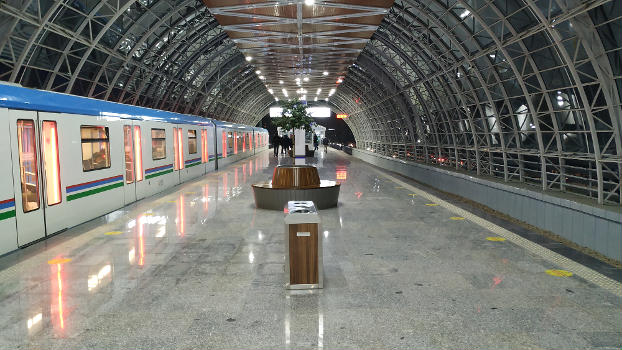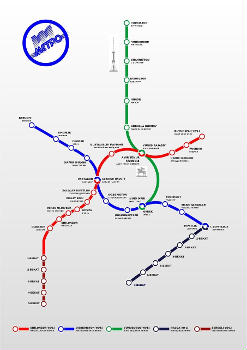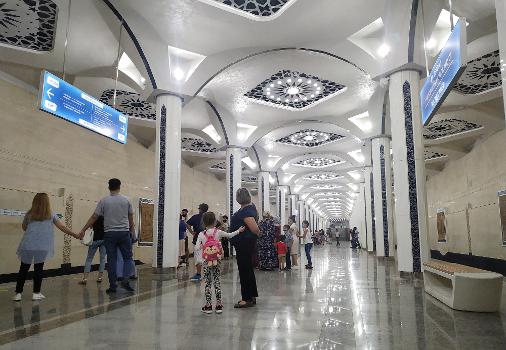General Information
| Completion: | 6 November 1977 |
|---|---|
| Status: | in use |
Project Type
| Function / usage: |
Metro (rapid transit) network |
|---|
Location
| km | Name |
Technical Information
Dimensions
| number of stations | 50 | |
| system length | 70.4 km | |
| track gauge | 1 520 mm | |
| number of lines | 4 |
Excerpt from Wikipedia
The Tashkent Metro (Uzbek: Toshkent metropoliteni, Тошкент метрополитени) is the rapid transit system serving the city of Tashkent, the capital of Uzbekistan. It was the seventh metro to be built in the former USSR, opening in 1977, and the first metro in Central Asia. Each station is designed around a particular theme, often reflected in the station name.
The Tashkent Metro consists of four lines, operating on 70.4 kilometres (43.74 mi) of route and serving 50 stations. In 2023, the metro carried 190.7 million passengers, which corresponds to a daily average of approximately 620,000 passengers.
History
Planning for the Tashkent Metro started in 1968, two years after a major earthquake struck the city in 1966. Construction on the first line began in 1972 and it opened on 6 November 1977 with nine stations. This line was extended in 1980, and the second line was added in 1984. The most recent line is the Circle (Halqa) Line, the first section of which opened in 2020.
A northern extension of the Yunusobod Line for 2 stations Turkiston and Yunusobod was completed and opened on 29 August 2020. The fourth Circle line is currently under construction, first 7 stations for the line have already been built in 2020.
Operations
The Tashkent Metro operates 3 regular lines and a 1 circle line (under further extension), which currently runs 66.5 km (41.32 mi) of route and serve 48 stations. The metro network employs more than 4,200 staff. In 2021, revenues from fares amount to 10.5 billion soum a month.
The depth of the metro's tunnels varies between 8–25 metres (26 ft 3 in – 82 ft 0 in). The strong construction of these three lines can resist earthquakes of a magnitude of 9.0 on the Richter scale. It sports a 1,520 mm (4 ft 11+27⁄32 in) gauge and a third rail power supply (825 V DC). The average station distance is 1.40 kilometres (0.87 mi).
Lines
Chilonzor Line (red)
Construction on this line started in 1968, opened in 1977 between Olmazor (previously named as Sabir Rakhimov) and Amir Temur Khiyoboni (previously named as Oktyabr Inqilobi) including Novza (previously named as Khamza) depot and one metro bridge over Oqtepa channel between Novza and Milliy Bog' (previously named as Komsomolskaya) stations. It was extended to Buyuk Ipak Yoli (previously names as Maksim Gorkiy) in 1980 (including another metro bridge over Salar river between Hamid Olimjon and Pushkin stations). It is 23.7 kilometres (14.73 mi) long with 17 stations.
A 7 km (4.35 mi) extension of the Chilonzor Line south from Olmazor station to Quipchoq (5-Bekat) station in the Sergeli district of Tashkent was built in 3 years and inaugurated by President Shavkat Mirziyoyev on 26 December 2020.
The future planned 3 stations eastward extension from Buyuk Ipak Yoli to TTZ (Toshkent Traktor Zavodi) is under consideration.
Oʻzbekiston Line (blue)
The route of this line crosses the city diagonally from northwest to southeast via the Toshkent Railway station. It opened in 1984 and expanded between 1984 and 1991. It is 14.3 kilometres (8.89 mi) long with 11 stations.
Yunusobod Line (green)
Work is under way on this line to connect the northern districts to the airport in the south. The first 10.5 kilometres (6.52 mi) section with 8 underground stations opened for regular service on 24 October 2001 between Mingurik and Shahriston (previously named as Habib Abdullayev).
Circle Line (gold)
Construction of new line started in October 2017. The project will be completed in 5 stages and developed and implemented jointly with specialists from Russia, Turkey and Germany. When completed, the Circle line will serve 35 stations and it will be 52.1 kilometres (32.37 mi) long with an elevated above ground section of 50.5 kilometres (31.38 mi) on 6 meters (19 ft 8 in) overpasses and 1.6 kilometres (0.99 mi) on the ground level.
In February 2020, it was reported that construction of the first section of the Circle Line from Do'stlik to Qo'yliq stations was finished and that new rolling stock for the Circle Line was undergoing trials. On 30 August 2020, Circle line's first section was opened. It is 11 kilometres (6.84 mi) in length and has seven stations. An extension of the line from 7-Bekat to 12-Bekat opened on 25 April 2023.
Stations
Today, the Tashkent Metro has 48 stations that differ from each other. The architecture and décor of each station reflect its name. One peculiarity of the Tashkent metro is ist rather shallow depth. Some stations have escalators, 7 stations belong to the tower type, 4 stations to the arch type and one station (Mustaqillik Maydoni) to the tower-individual type. Prominent architects and artists of Uzbekistan took part in designing the stations. Materials used for the interior décor include metal, glass, plastic, granite, marble, smalt, ceramics and alabaster. Each station contains original works of art, and is based on a particular theme. After the break up of the Soviet Union in 1991 many stations were renamed to remove references to Communism.
Passenger regulations
Despite a wide range of artistic and architectural features in the metro, it was notably illegal to take pictures and/or video inside the metro until 31 May 2018, because they were considered military installations due to the system's secondary role as a nuclear bomb shelter. The government under the newly elected Shavkat Mirziyoyev, ruled that from 1 June 2018, taking photo and video is made allowed within the system.
Rolling stock
Like in all Soviet metro systems, the basic type of rolling stock is known as the 81-717/81-714. As of 2013[update], there are 168 81-717/714 train cars operational on the metro, and they are operated in the form 4-car trainsets serving the system's 100 metres (330 ft) station platforms. Trains have an average commercial speed of 46 kilometres per hour (29 mph). Services started with carriages of type Ezh3 and Em-508T. By the mid-1980s, all these cars were given to Baku and Tbilisi metro. In exchange, the metro has received trains of series 81-717/81-714, which are still in service today.
In 2001, Tashkent metro has received newer trains of 81-718/719. There were plans to purchase trains of series 81-717.6/714.6 for the metro but that didn't happen. There was a decision to modernize the existing 81-717 trains in the Tashkent Carriage Repair Factory. The first modernised train appeared in 2015.
In 2019 new trains of type 81-765/766/767 were ordered for the opening of the Circle line, and with ist opening they were given from Uzbekistan line to the Circle line. It is planned to purchase 45 trains of the newest type for the Circle line. If not, then Tashkent metro will receive trains of type 81-775/776/777 that are currently produced in Metrovagonmash.
In April 2021, Tashkent Metro signed a contract to purchase 10 new Russian-made trains from Metrovagonmash. The service life of metro cars and frames is 30 years. The windshield of the driver's cab will be equipped with an adjustable manual sunscreen, taking into account the peculiarities of the Tashkent metro; some of the Tashkent metro lines run on the ground.
Future extension plans
Besides building of Circle line around Tashkent metropolitan, Tashkent Metro is working on extension of the current metro lines to 10 more stations. By 2030, Tashkent Metro is planning to build 2 metro stations from the Beruniy station to Karakamysh district, 4 underground metro stations from the station Buyuk Ipak Yoli to TTZ (Toshkent traktor zavodi) neighborhood and 5-6 stations from the station Ming Orik to the Tashkent Janubiy (South) railway station.
In March 2021, Metro officials reported about second stage extension of the Circle line. This stage includes a section from the Kuylyuk market, through the Tashkent Ring Road to the capital's Yangihayot district, connecting Khanabad Street in the Zangiata district (Tashkent region) with Kipchak Street in the Sergeli district of Tashkent, including the "5-Bekat" station of the new Sergeli metro line. It is planned to build 9 stations on this stage with a total length of 15 kilometres (9.32 mi).
The Kuylyuk – Kipchak – Yangihayot section is expected to serve about 46 thousand passengers daily. Also, about 700 new jobs will be created.
Additionally it is planned to build another line of metro to the new district of New Tashkent, which is going to be more than 15 kilometers long and contain more than 6 stations at least if it is going to be built.
In March 2021, the Tashkent Metro carried up to 330,000 passengers a day on weekdays and 150,000 passengers on weekends. The goal is to increase the number of passengers to 1 million per day.
Text imported from Wikipedia article "Tashkent Metro" and modified on November 5, 2024 according to the CC-BY-SA 4.0 International license.
Participants
Currently there is no information available about persons or companies having participated in this project.
Relevant Web Sites
- About this
data sheet - Structure-ID
20089668 - Published on:
05/11/2024 - Last updated on:
05/11/2024


